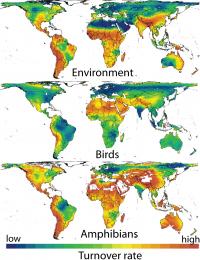Oct 28 2008
Biologists have long suspected that amphibians, whose moist permeable skins make them susceptible to slight changes in the environment, might be good bellwethers for impending alterations in biodiversity during rapid climate change.
 The study found that species turnover in amphibians more closely follows changes in the environment when compared to birds. Credit: Lauren Buckley, UCSB
The study found that species turnover in amphibians more closely follows changes in the environment when compared to birds. Credit: Lauren Buckley, UCSB
Now two University of California biologists have verified the predictive power of this sensitive group of animals in a global study of species turnover among amphibians and birds. The study appears this week in the advance online version of the journal Proceedings of the National Academy of Sciences.
"Our study supports the role of amphibians as 'canaries in the coal mine'," said Lauren Buckley, a postdoctoral fellow at UC Santa Barbara's National Center for Ecological Analysis and Synthesis and the first author of the study. "Amphibians are likely to be the first to respond to environmental changes and their responses can forecast how other species will respond."
"Amphibians are much more tuned in to the changes in their specific environments," said Walter Jetz, an associate professor of biology at UC San Diego and the other author of the study. "They are much more sensitive to differences in environmental conditions as you move geographically from one location to another."
The two scientists used maps of the environment and amphibian and bird distributions to answer the question of how the environment - as well as the distribution of birds and amphibians - changes as one moves from one place to another around the globe.
The researchers found that if the environment changes rapidly as one travels from one location to another, the amphibian and bird communities also change rapidly. However, the species of amphibians would change more quickly than species of birds. This confirms that amphibians are particularly sensitive to changes in the environment, the researchers conclude, and that this sensitivity is particularly acute given their narrow distributions.
Whether one is traveling through a tropical or temperature region also influences how quickly the types of animals change. Given a mountain of a certain size, the researchers found, the amphibian and bird communities change more quickly if one is climbing a mountain in the tropics than in a temperate region.
"There are more species in the tropics and the species are generally more specially adapted to particular environmental conditions," said Jetz. "This suggests that tropical species may be more severely impacted by a given temperature increase as a result of climate change."
For the study, he and Buckley produced a series of global maps of environmental turnover and the associated changes in amphibian and bird communities that reveal that the identities of birds and amphibians change particularly quickly in mountainous regions such as the Andes and Himalayas.
"Understanding how environmental changes over space influence biodiversity patterns provides important background for forecasting how biodiversity will respond to environmental changes over time such as ongoing temperature increases," said Buckley.